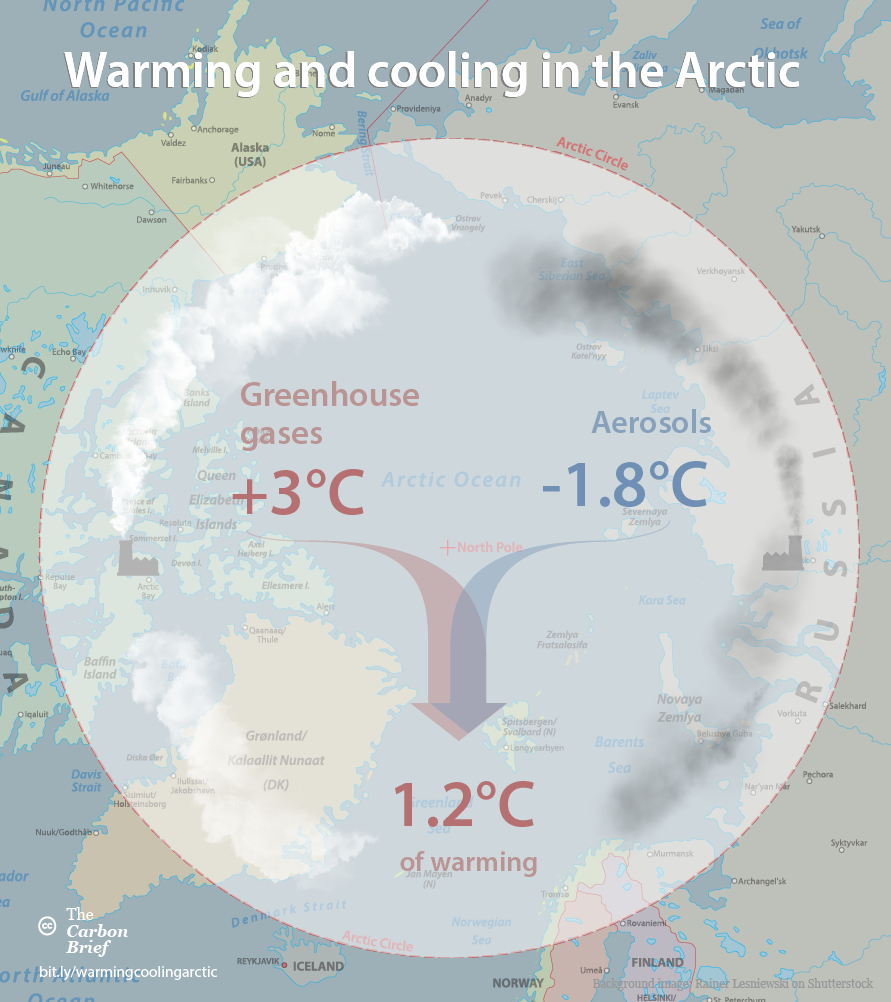Not all aerosols warm. Sulphate particles, for example, can cause
a dip in surface temperatures as a result of their ability to reflect infra-red
radiation. For geoengineering purposes (Solar
radiation management) or a “quick fix” against climate change, sulphates have
provided a shining light as a new method to combat rising temperatures. Aerosols,
injected into the atmosphere, reflect solar radiation back into space, thus
preventing it reaching the earth’s surface. This is hoped to contradict the warming
effects of greenhouse gases.
 |
| Najafi et al (2015) |
So back to the Arctic…
Warming is occurring at an amplified rate within the Arctic.
A study recently published in Nature
Climate Change suggests aerosols could be used as a method of slowing the
rising temperatures. The paper highlights the ability of aerosols to scatter radiation and cause clouds to form. Modelling results suggests greenhouse gases
were going to cause a 3 degrees Celsius warming over the Arctic, yet the rise
in temperature currently stands at only 1.2. The difference between predicted
and observed can be accounted to the cooling influence of sulphates. This
demonstrates the potential of SRM schemes, especially in the Arctic.
It is important to remember SRM, as a method of mitigating
climate change, does not come without risks. A friend of mine covers the topic
of Solar
Radiation Management in her blog and highlights the risks associated with
this type of geoengineering. Aerosols only influence the climate for approximately
2 years before being removed, from the atmosphere, by precipitation. A greater
concentration of sulphates can result in a lower pH
rainwater (acid rain). Secondly, the uncertainty associated with these
methods is still high and the failure of these schemes could subject the earth
to rapid
warming, at a greater rate and to higher temperatures than current.
Thoughts:
Before I began engaging with the literature surrounding this
topic I recorded my initial opinion as I was interested to see if it had
changed: “I believe geoengineering is not
a good mitigation strategy. Messing with the natural climate system will only
end badly and the negative impacts of aerosols (in the Arctic especially) has
not been considered holistically. Based on what I have read this is not going
to be a long term fix for climate change. In the Arctic, aerosols have a series
of negative effects including changes to the composition of clouds, which has
not been considered.”
I started this blog seeing all types of pollution as
negative, but after reading this I have been shown that aerosols are not all
bad. Any method which can slow the warming in the Arctic must be positive! However
the future isn’t so bright. Predictions show anthropogenic productions of
aerosols are predicted to decline
(whilst greenhouse gases continue to rise), indicating rate of warming within
the Arctic will increase in the near future.
This is a very controversial topic and I would be very
interested to hear your opinions so please comment and let me know!
I can't believe you might be changing your ways against geoengineering Charlie ;)! I'm open minded to the use of aerosols, but I think any messing with the climate system intentionally (as opposed to "unintentionally" with fossil fuels etc) is asking for trouble. I'll see if you can persuade me otherwise with aerosols.
ReplyDeleteIf we keep declining and cutting down aerosols, you're right...will this make the Arctic warm even quicker? What do you think about using a mix of black carbon alongside sulphates to strike a balance between warming and cooling?
Yes, cutting aerosols emissions in the Arctic will cause the region to warm at a greater rate than present, but we must remember my previous post that aerosols can also have warming influences (through changing cloud properties).
ReplyDeleteIn terms of black carbon i do not think the Arctic needs any more pollutants which warm (as BC absorbs radiation, check out some of my most recent posts for info on this) and policies need to be implemented to cut BC emissions, but that is besides the point. Green house gases alone provide enough warming in the Arctic and i do think this benefit of sulfates must be considered before we make such an effort to reduce emissions, as they may not go down as swimmingly when the Arctic ice melts.